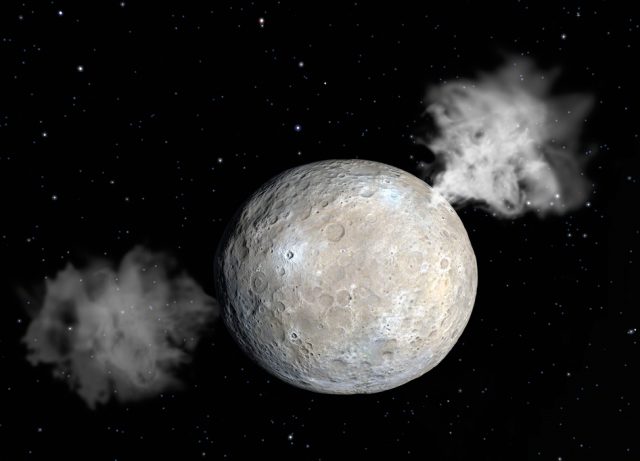Breathing planet
Ceres was discovered by Giuseppe Piazzi in the very first day of the XIX century somewhere between Mars and Jupiter orbits. It was once considered the biggest asteroid in the Solar System but the 2006 Pluto demotion resulted in an upgrade of Ceres into the newly created dwarf-planet category, in which it became the smallest member. Whatever you want to call, it is in any case a round body with less than 1,000 km diameter, meaning that even our beloved Moon is bigger than it. It has been recently shown by Küppers and collaborators 1 that, as longly suspected, Ceres is indeed emitting water vapor at some points on its surface. This somehow defies the common picture of a rigid water snow line in our Solar System, with asteroid belt objects falling on the dry side and showing that the distribution of minor bodies was largely affected by the early days of Jupiter and Saturn migration.

We have to thank again Herschel Space Observatory and its Heterodyne Instrument for the Far Infrared (HIFI) for this discovery. Its sensitivity provided the tool for detecting water vapor in Ceres surroundings, even though the angular resolution (some 40 arcsecs) was much bigger than the actual size of the dwarf-planet as seen from the satellite (roughly 1 arcsec). The spectral sensitivity was instead the key to not only detect the water absorption line at 556.939 GHz but also to determine by means of the Doppler shift the location on the surface responsible of it. The line intensity displayed variations at some time scales, being the short ones thought to be related to Ceres rotation, and others at longer time scales yet to be explained. All in all, HIFI observed the planet four times from November 2011 to March 2013, giving significant insights into the elusive presence of water on its surface.

Apart from the mere discovery of water escaping from Ceres, there are some striking results arising from this work. First, the water seems to come from region on the surface that are about 5% darker than the average. It is very likely that those spots are warmer than other locations, allowing sublimation of the ice expected to be covering the surface. We have a relatively good knowledge of the aspect of Ceres surface as it has been imaged at high resolution in the past (as for example shown in 2). There is also a long-term evolution of the amount of water released as the asteroid travels from some 3 AU from the Sun to closer regions at 2.72 AU, in good agreement with our understanding of the water ice line. Finally, it is also possible to estimate the water production rate from Herschel measurements , which would be a tiny fraction of the ice potentially available at the surface.
There are basically two ways to get the water vapor sublimating. It could be produced, as in comets, by sublimation of near surface ice or it could be generated by geysers or cryovolcanism as it happens for example in Enceladus, a Saturn’s moon. Whereas in Enceladus the tidal forces generate the required heating in the interior, this role would be played in Ceres by radioisotopes. A good way to disentangle the origin of water vapor would be to determine the correlation (or lack of) with the planet’s distance to the Sun. As of this writing, it seems to be a reasonable agreement with this hypothesis but more observations are certainly required.

As pointed out by Campins and Comfort 3 in the News & Views companion to Küppers’ paper, this discovery for Ceres poses an interesting comparison with Vesta, another inhabitant of the asteroid belt, one very close to the other. In contrast with Ceres, Vesta has undergone substantial volcanic eruptions and is at present, notably drier. It is possible that the water ice in Ceres was the key to dissipate the interior heat more efficiently without requiring volcanism. Our protagonist was very likely formed in the outer Solar System but the migration of giant planets Jupiter and Saturn, which disturbed the population of smaller bodies, resulted in two quite different neighbors living in the same region of the Solar System.
In spite of Herschel Space Observatory death, we are lucky enough to have NASA Dawn mission out there at the asteroid belt. The spacecraft is expected to study Ceres since 2015 onwards, after studying Vesta in 2012. This mission will provide the required long-term monitoring of water emissions from Ceres although the dwarf-planet will be passed perihelion by that time and outgassing might be reduced with respect to the present time. In the meantime, we will trust on ground-based observations to follow the breath of this small dwarf-planet.
References
- Küppers M., O’Rourke L., Bockelée-Morvan D., Zakharov V., Lee S., von Allmen P., Carry B., Teyssier D., Marston A. & Müller T. & (2014). Localized sources of water vapour on the dwarf planet (1) Ceres, Nature, 505 (7484) 525-527. DOI: 10.1038/nature12918 ↩
- B. Carry et al. (2008). Near-infrared mapping and physical properties of the dwarf-planet Ceres. Astronomy & Astrophysics 478, 235 – 244. doi: 10.1051/0004-6361:20078166 ↩
- H. Campins and C. M. Comfort (2014). Evaporating asteroid. Nature 505, 487 – 488 ↩
1 comment
so what is your current view of the white spots? some weird water / vulcanism / ice thing going on?